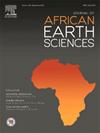Machine learning approaches for predicting reservoir lithofacies: Geological implications in the Tendrara-Missour basin, Morocco
IF 2.2
4区 地球科学
Q2 GEOSCIENCES, MULTIDISCIPLINARY
引用次数: 0
Abstract
Lithofacies identification is crucial for reservoir characterization, as reservoir quality is closely tied to lithofacies distribution, directly impacting hydrocarbon recovery. Conventional core analysis, while informative, is often limited to partially cored reservoirs. Well logs, such as gamma ray, density, and sonic logs, offer continuous reservoir information, making them valuable for lithofacies identification. In the Tendrara-Missour basin, four TAGI (Trias Argilo-Gréseux Inférieur) reservoir lithofacies were identified: sandstone, pebbly sandstone, conglomerate, and claystone-siltstone.
This research represents the first application of machine learning for reservoir lithofacies identification in Morocco, aimed to predict and reconstruct lithofacies in 417 m of non-cored sections from three wells using machine learning models: Random Forest (RF), Multi-Layer Perceptron Neural Network (MLPNN), and Cluster Analysis (CA). MLPNN achieved the highest accuracy (87%), capturing complex non-linear relationships in well-log data. RF performed reasonably well (82%) but struggled to differentiate pebbly sandstone from conglomerate due to similar log responses. CA, with an accuracy of 44%, faced challenges distinguishing lithofacies with overlapping log responses.
The MLPNN model revealed rapid lateral lithofacies variation despite well proximity and identified fining upward sequences, indicating energy transitions typical of fluvial and alluvial settings. These findings underscore the effectiveness of machine learning in reservoir characterization, offering a cost-efficient alternative to extensive core analysis. The successful application of the MLPNN model in well log data demonstrates its suitability for lithological discrimination, making it a valuable tool for reservoir studies. Future integration of MLPNN results with seismic data could further enhance lithofacies mapping and support hydrocarbon exploration and reservoir management efforts in the Tendrara-Missour basin.
求助全文
约1分钟内获得全文
求助全文
来源期刊

Journal of African Earth Sciences
地学-地球科学综合
CiteScore
4.70
自引率
4.30%
发文量
240
审稿时长
12 months
期刊介绍:
The Journal of African Earth Sciences sees itself as the prime geological journal for all aspects of the Earth Sciences about the African plate. Papers dealing with peripheral areas are welcome if they demonstrate a tight link with Africa.
The Journal publishes high quality, peer-reviewed scientific papers. It is devoted primarily to research papers but short communications relating to new developments of broad interest, reviews and book reviews will also be considered. Papers must have international appeal and should present work of more regional than local significance and dealing with well identified and justified scientific questions. Specialised technical papers, analytical or exploration reports must be avoided. Papers on applied geology should preferably be linked to such core disciplines and must be addressed to a more general geoscientific audience.
 求助内容:
求助内容: 应助结果提醒方式:
应助结果提醒方式:


